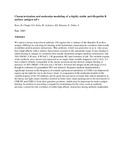| dc.contributor.author | Bose, B | |
| dc.contributor.author | Chugh, DA | |
| dc.contributor.author | Kala, M | |
| dc.contributor.author | Acharya, KS | |
| dc.contributor.author | Khanna, N | |
| dc.contributor.author | Sinha, S | |
| dc.date.accessioned | 2013-07-03T15:21:22Z | |
| dc.date.available | 2013-07-03T15:21:22Z | |
| dc.date.issued | 2003 | |
| dc.identifier.citation | KIRTDA, DRACHARYAS. 2003. Bose B, Chugh DA, Kala M, Acharya SK, Khanna N, Sinha S.Characterization and molecular modeling of a highly stable anti-Hepatitis B surface antigen scFv.Mol Immunol. 2003 Dec;40(9):617-31. | en |
| dc.identifier.uri | http://profiles.uonbi.ac.ke/sacharya/publications/bose-b-chugh-da-kala-m-acharya-sk-khanna-n-sinha-scharacterization-and-molecul | |
| dc.identifier.uri | http://erepository.uonbi.ac.ke:8080/xmlui/handle/123456789/44902 | |
| dc.description.abstract | We raised a mouse monoclonal antibody (5S) against the 'a' epitope of the Hepatitis B surface antigen (HBsAg) by selecting for binding of the hybridoma supernatant in conditions that usually destabilize protein-protein interactions. This antibody, which was protective in an in vitro assay, had a high affinity with a relative dissociation constant in the nanomolar range. It also displayed stable binding to antigen in conditions that usually destabilize antigen-antibody interactions, like 30% DMSO, 8 M urea, 4 M NaCl, 1 M guanidium HCl and extremes of pH. The variable regions of the antibody were cloned and expressed as an single chain variable fragment (scFv) (A5). A5 had a relative affinity comparable to the mouse monoclonal and showed antigen binding in presence of 20% DMSO, 8 M urea and 3 M NaCl. It bound the antigen in the pH range of 6-8, though its tolerance for guanidium HCl was reduced. Sequence analysis demonstrated a significant increase in the frequency of somatic replacement mutations in CDRs over framework regions in the light but not in the heavy chain. A comparison of the molecular models of the variable regions of the 5S antibody and its germ-line precursor revealed that critical mutations in the heavy and light chains interface resulted in better inter-chain packing and in the movement of CDR H3 and CDR L1 from their germline positions, which may be important for better antigen binding. In addition to providing a reagent for neutralizing for the virus, such an antibody provides a model for the evolution of stable high affinity interaction during antibody maturation. | en |
| dc.language.iso | en | en |
| dc.title | Characterization and molecular modeling of a highly stable anti-Hepatitis B surface antigen scFv | en |
| dc.type | Article | en |
| local.publisher | Department of Medicine, College of Health Sciences, University of Nairobi | en |

